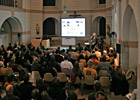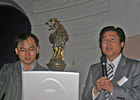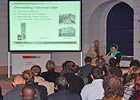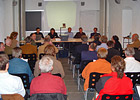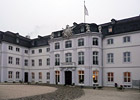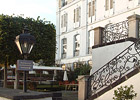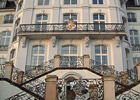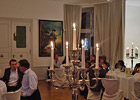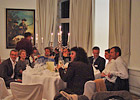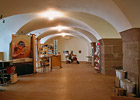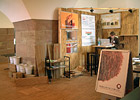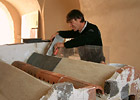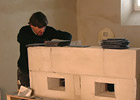The LEHM 2008 – a milestone in networking building with earth
With over 170 participants from 24 countries and 5 continents, the Dachverband Lehm e.V. can justly be proud of a most successful 5th international conference on building with earth. Organised by the German Association for Building with Earth (DVL), it took place at the historic Fort Ehrenbreitstein in Koblenz, overlooking the junction of the Rivers Mosel and Rhine. The conference was organised in co-operation with the GDKE Rhineland-Pfalz Ministry of Cultural Heritage / Landesmuseum Koblenz and Koblenz Chamber of Crafts.
View from Fort Ehrenbreitstein
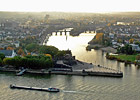


The fortress makes an imposing sight. Built during Prussian times, it sits atop a steep-sided hill and is accessible only from the north. Beneath it barges and ships pass by on the River Rhine ferrying goods and tourists. Once the morning mist over the river had subsided, one was rewarded for the steep ascent with a truly majestic view from the plateau at the top of the fortress over the red and golden autumnal landscape. Just as the conference began, the weather relented, giving way to a few days of autumnal sunshine and it was warm enough to sit outside in the restaurant garden to enjoy food and the view, along with the ever persistent wasps.
The plateau at the top of Fort Ehrenbreitstein
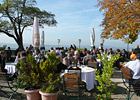

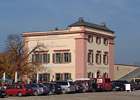
The conference took place in the fort's church, in historic if somewhat chilly surroundings. Pullovers, jackets and scarfs held off the initial chill until attention shifted to the presentations. Not long after, the general presence of the participants warmed up the room, which filled so rapidly that extra chairs had to be brought in to provide enough seating. Two translators provided simultaneous translations via headseats in German and English. Where the subject matter exceeded their technical knowledge, visitors and DVL members stepped in with competent advice.
The evening reception and buffet dinner in the Baroque mansion “Schloss Engers” near Neuwied on the outskirts of Koblenz, was a warmer occasion in many respects. The late baroque building, which is today home to the Regional Foundation for Music, Villa Musica, and houses a museum of musical instruments and paintings, has a first-class restaurant in the basement and a terrace overlooking the Rhine. A buffet with culinary delicacies awaited the conference participants along with local wines grown on the slopes up and down the Rhine. After the relatively tightly-packed conference programme, it was an opportunity to make contact and exchange experiences in a more relaxed atmosphere, to wander through the spacious rooms of Schloss Engers and to sit outside on the banks of the Rhine. Many guests stayed until late in the night forging contacts and the pianist's improvisations on the piano helped provide a conducive atmosphere.
A trade fair for building with earth, which was also open to the general public, took place in one of the fort’s freshly renovated bastions and complemented the conference providing a further informative and interesting aspect to the LEHM 2008. Despite extensive advertising in advance, there were fewer visitors than expected. Several business members of the DVL presented their products and Manfred Fahnert, also a member of the DVL, built a scale model of the fort’s roof construction over several days, with thick earth vaulting. Here earth had been used as an expendable ‘military material’ to absorb the impact of cannonballs!
The opportunity to exchange experiences with colleagues from around the world proved particularly fruitful. The DVL's initiatives since 1992 in developing building norms, a recognised training standard in craft skills, in developing building techniques and materials and generally promoting a culture of building with earth in Germany has been pioneering. Since then many new earth building asssociations have been founded in Europe and around the world. Many of them are faced with the same hurdles and problems we have been tackling for several years. Conferences such as the LEHM allow us to learn directly from one another and to support each other and this was particularly evident in the LEHM 2008.
The often exceptional presentations and posters gave us an insight into earth building in Austria, Spain, Ghana, Thailand, France, Nigeria, Poland, South Korea, England, India, Venezuela, Bangladesh, Malaysia, Estonia, Mexico, the Czech Republic, Marocco, Iran and the USA. And, of course, in the different regions of Germany. The presentations focussed on six main topics:
1. Earth building norms and regulations
2. Education and training in earth building
3. Current research into building with earth
4. Information networks in earth building
5. Current problems in earthen building practice
6. New projects and exemplary conversions forum
The programme was tightly packed and the speakers had to discipline themselves to stay within the alloted time to allow sufficient time for questions and comments. From time to time the session moderators, all members of the DVL, had to intervene in some of the 21 presentations. 23 posters, many of them attractively presented, complemented the presentations.
As with the previous LEHM conference in 2004, the DVL published the conference proceedings in book form to accompany the conference. Participants received a copy as part of their attendance, further copies are available from the DVL secretary at a cost of 50 Euro (plus postage). The proceedings contain all the speaker and poster presentations in English and in German.
The conference took place on Friday, 10th October and Saturday, 11th October. Saturday afternoon was reserved for the Association's annual general meeting. On Sunday three day trips were planned. The first visited new earth buildings and production facilities in the region, a second historical earth building in Koblenz, Limburg and Weilburg and the third the Archaeological Park in Xanten to visit the reconstructions of Roman rammed earth buildings. The first two trips began with a joint visit to the premises of DVL member Gerd Meurer, who has renovated a half-timbered house on the banks of the Rhine in Koblenz-Neuendorf. It now serves as their home and as a ‘display cabinet’ for their natural building material and wall heating business.
The day trip began with a visit to Gerd Meurer and WEM
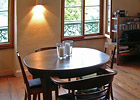
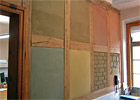
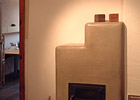
The first port of call for the trip to visit new earth buildings and production facilities was KTS Kärlicher Ton- und Schamottewerken (Mannheim & Co. KG), including their earth works and product palette. From there Udo Heimermann led the group to “Haus Harmonie”, a nursing home for the elderly in Hohenleimbach with a pronounced organic, naturalistic form.
I can only relate a first-hand account of the historical earth building day trip, which included a walk through the historic old town of Limbung with many old, well-preserved half-timbered buildings and a trip to nearby Weilburg, which boasts a handful of historical rammed earth (Pisé) buildings. The hilly topography of the town with its many steps was for some tiring, myself included, but the beauty of the town and the old buildings in the golden autumn sunlight was worth the exertion.
"Historical Earth Building" day trip – Half-timbered and earth buildings in Limburg
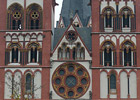
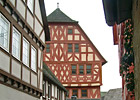
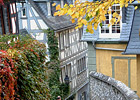
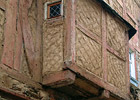

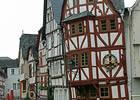
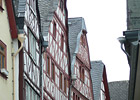
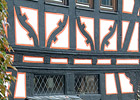
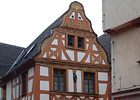
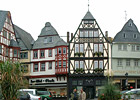
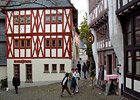
"Historical Earth Building" day trip– Rammed earth buildings in Weilburg

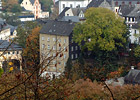
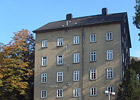
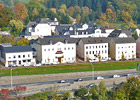
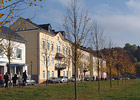
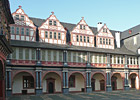
In Xanten, Dr. Kienzle and Christof Ziegert led the participants on an interesting tour of the complex at the Archaeological Park, which had been the subject of a presentation on the previous day: new reconstructions of Roman rammed earth buildings. The various tours met up in the evening at Koblenz railway station before making their way home, for some nearby for others on the other side of the world. We hope that the experiences of the LEHM 2008 will continue to inform everyone's activities for some time to come!
Day trip to Xanten Archaeological Park
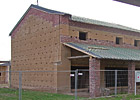
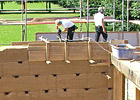
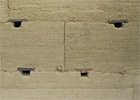
The first feedback has been overwhelmingly positive, both regarding the organisation of the LEHM 2008 as well as the quality of the presentations and posters submitted and presented. Make a mental note to join us again in 2012 for the next DVL-organised international conference on building with earth, which will coincide with the 20th anniversary of the founding of the Dachverband Lehm e.V. It will be interesting to see how established and fledgling organisations will develop over the next four years and how effective and useful the networking at a global level has proven to be.
Hannah Schreckenbach, 20th October 2008
Magdeburg
The Dachverband Lehm e.V. would like to thank all speakers, poster session contributors and participants for their contributions and ongoing commitment to earth building which was central to the success of the conference.
An Errata sheet for the Conference Proceedings can be downloaded here.


